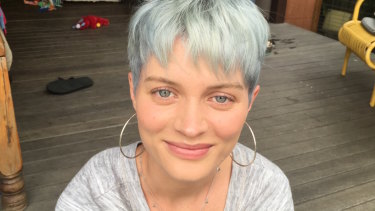In December 2017, after three very expensive visits to a gynaecologist, I had a Mirena IUD inserted to manage the pain associated with my periods. Two weeks later I was on the couch in agony.
Walking past, my uncle asked what was wrong. “Period pain,” I responded.
“Ugh,” he said. "Too much info.”
Rose Dooley faced a two-year wait for surgery which would diagnose her endometriosis.
It was in fact, not that much info. I had not told him this was the second IUD I’d had, as the first was accidently ripped out upon insertion by my gynaecologist (and I had then held the speculum while they ran to the chemist to get another), or recalled the time I passed out in a public toilet and, knowing nothing could relieve the pain, lay there counting the tiles on the wall for a few hours.
I even refrained from saying a doctor had previously told me fatigue and pain during sex could mean I was asexual (“Heard someone talking about it on the radio – have you googled it?”), and that, after my therapist said I could be experiencing a type of “ghost trauma pain” from a sexual assault at the age of 16, I had briefly resorted to hypnotherapy. (It didn’t work. Neither did the yoga exercises; it is very hard to do downward dog when you haven’t slept for 48 hours from abdominal spasms.)
You can imagine my relief when, at the end of last year, I saw a specialist endometriosis excision surgeon who didn't think my complaints were too much information.
I made the trip after discovering Nancy's Nook, a global online resource for people with endometriosis (a painful disorder in which the tissue lining the uterus grows elsewhere inside the body). Among other things, the page includes a list of doctors recommended by former patients.
It took months to get in, but it was worth it. It was the first time in 10 years someone had listened.
Overwhelmed with validation, I stumbled to the reception after my consult and asked what the next step was. I was informed it depended on my level of private health cover but, if I could provide my fund details, I could potentially have a laparoscopy (keyhole surgery to examine the abdomen) to determine if I had endometriosis within a month.
There is no cure for endometriosis yet.Credit:Shutterstock
"What if I don’t have private health insurance?"
The receptionist looked at me blankly and began to write numbers on a notepad. When the additions reached $10,000 I began to cry. The public waiting list? Two years, and still not completely funded by Medicare.
My financial situation placed me in an odd limbo: I had enough money to cover gynaecologist appointments where I was told the possible diagnosis and how it could be confirmed, but nowhere near enough to fund the top tier private health cover that treatment for this condition requires.
The receptionist looked at me blankly and began to write numbers on a notepad. When the additions reached $10,000 I began to cry.
In January this year I dropped out of university to work more, to save for the surgery, but I couldn’t get enough work. I am employed under a casual contract and have no sick leave entitlements, so if my pain is too bad to work I just don't receive any pay that day.
By the end of a shift I rarely had enough energy to make it to the bus stop. Most frustratingly, I didn’t have a diagnosis to explain to people why I was struggling.
I spent any money that didn’t go to rent on psychologist visits and Ubers home from work.
As I struggled to come up with the $10,000 figure, my mum decided to “bite the bullet” and dip into her superannuation to help me. After booking the surgery at a private hospital, she called to enquire about payment.
In the months since I saw the surgeon, the cost had gone up. We were quoted $16,398. We cancelled the same day.
It wasn’t until I ended up in a psychiatric ward that I was able to have my surgery in the public system.
Armed with my GP’s compelling – if not vaguely aggressive – letter of recommendation regarding my plummeting mental health, I returned to the specialist to let them know I couldn’t afford the $16,000 bill but I needed to be put on the public waiting list.
Somehow, the stars aligned for me. There was a new, younger, gynaecologist now doing surgeries who had studied under my original specialist. Not only did they take me on as a public patient with only a one month wait for surgery, they decided to not charge me the specialist fee. Within one week I had gone from a $16,000 surgery, to a no-gap surgery.
Of course, this is how it should be for everyone.
Surgery is the only way to formally diagnose endometriosis and, without this doctor’s compassion, I would have chosen a life of untreated chronic pain over the psychological and financial distress of a $16,000 gamble. I would never have known what to call the condition that has played havoc with my life for a decade.
For many of the one in 10 women who have endometriosis, that knowing never comes. Without savings or private health cover, the specialists are too expensive, and the thought of a potentially pointless surgery (they could, after all, find nothing) is not only daunting but completely financially impossible. They are condemned to a life of hurt and, what’s worse, they carry it alone because no one will listen.
There is no cure for endometriosis yet. Imagine the difference if we treated women’s chronic pain – regardless of their financial situation – like it mattered.
Rose Dooley is a 24-year-old disability support worker from Sydney.
Source: Read Full Article


